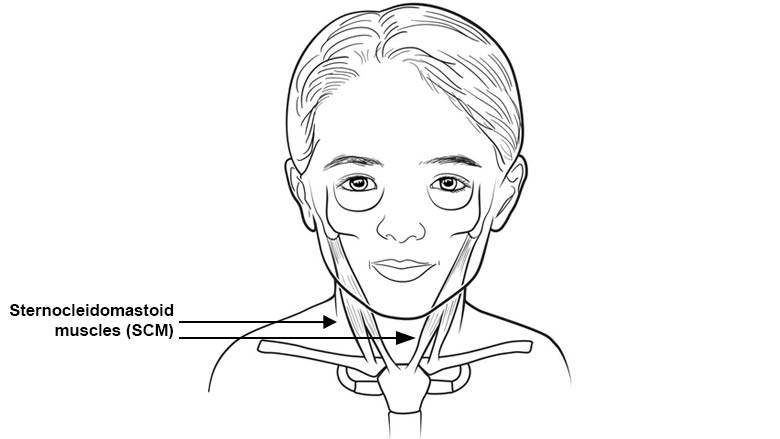Congenital Muscular Torticollis
What is congenital muscular torticollis?
Congenital muscular torticollis (CMT) is a postural condition in which an infant's neck muscle may be shortened, causing the neck to twist.
Congenital means present at birth, torticollis means twisted neck.
What causes congenital muscular torticollis?
The cause of congenital muscular torticollis is still being researched. Current ideas include that it may occur because of how the baby is positioned in the womb. Less frequently, it is thought to occur after a difficult birth, especially if the infant is delivered breech. Prolonged positioning or forceful stretching of the sternocleidomastoid muscle, the neck muscle that extends from the jawbone (mastoid) to the clavicle (collarbone) and sternum (breastbone), causes muscle strain, which causes the muscle to shorten and tighten, pulling the infant's head to one side. The injured muscle may also develop fibrosis (scar tissue). Sometimes the fibrosis forms a mass or lump that can be felt on the side of the neck.

What are the symptoms of congenital muscular torticollis?
Congenital muscular torticollis may be visible at birth or it may not become evident until several weeks after birth. The following are the most common symptoms of congenital muscular torticollis. However, each child may experience symptoms differently. Symptoms may include:
- Baby tilts or turns their head consistently to one side
- Baby struggles to feed more on one side
- Baby’s head is flat on one side, back or front
- Baby avoids turning head to one side
- Baby prefers to use one hand more than the other when reaching or putting hand in mouth
- Firm, small, one to two-centimeter lump is felt in the middle of the sternocleidomastoid muscle
The symptoms of congenital muscular torticollis may resemble other medical problems. Always consult your child's healthcare provider for a diagnosis.
How is congenital muscular torticollis diagnosed?
Physical examination of the infant may show the characteristic tilting of the head with opposite rotation and a tight sternocleidomastoid muscle. Sometimes, there is a lump (mass) in the middle portion of the muscle. In other cases, the infant has a preferred pattern of movement but not muscle tightness. In addition to a complete medical history and physical examination, diagnostic procedures may be used to rule out other medical conditions:
-
X-rays. A diagnostic test that uses invisible electromagnetic energy beams to produce images of internal tissues, bones, and organs onto film to check for abnormalities in the bones of the neck and shoulders. X-rays are typically needed after an infant has tried conservative treatment and is not getting better.
-
Ultrasound examination. A diagnostic imaging technique that uses high-frequency sound waves and a computer to create images of blood vessels, tissues, and organs to evaluate the muscle around the mass. Ultrasounds are used to view internal organs as they function and to assess blood flow through various vessels.
Treatment of congenital muscular torticollis
98% of infants with congenital muscular torticollis achieve normal range of motion within 1.5 months of physical therapy intervention if physical therapy is started before one month of age. However, if the condition is not corrected, the infant will be unable to move their head properly. Permanent muscle tightening can result in asymmetry (uneven development) of motor skills or of the neck and face. Specific treatment of congenital muscular torticollis will be determined by your child's healthcare provider based on the following:
- Your child's age, overall health, and medical history
- Extent of the condition
- Your child's tolerance for specific medications, procedures or therapies
- Expectations for the course of the condition
- Your opinion or preference
Treatment may include:
- Gentle stretching exercise program (to help relieve the tension and lengthen the sternocleidomastoid muscle)
- Infant stimulation (to help the infant learn to move and stretch the muscle)
- Surgery (to correct the shortened muscle) in rare cases
Babies at risk for congenital muscular torticollis may need special care to recover. Follow-up may include physical therapy or occupational therapy.
Reference:
Kaplan SL, Coulter C, Sargent B. Physical Therapy Management of Congenital Muscular Torticollis: A 2018 Evidence-Based Clinical Practice Guideline From the APTA Academy of Pediatric Physical Therapy. Pediatr Phys Ther. 2018 Oct;30(4):240-290. doi: 10.1097/PEP.0000000000000544. PMID: 30277962; PMCID: PMC8568067.